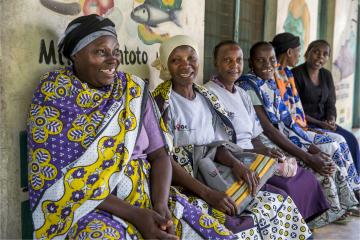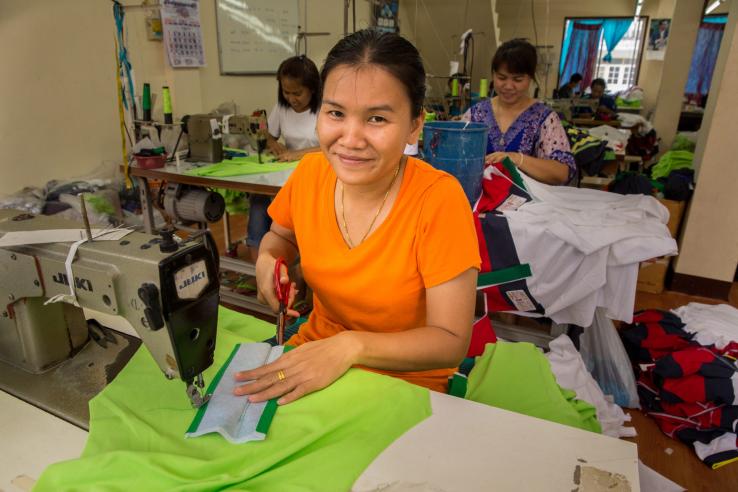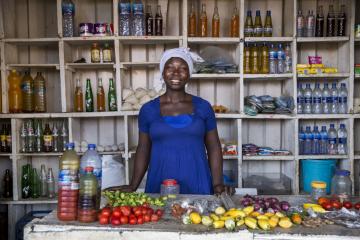
Growing the research agenda on women’s work

The Covid-19 crisis threatens to reverse decades of progress towards gender equality and exacerbates existing challenges women face in the labor market.
Through the Gender and Economic Agency Initiative (GEA), J-PAL is catalyzing a new body of innovative research on women’s work to support policymakers in implementing policies to support working women during and after the pandemic. GEA is now expanding our research portfolio with support from the Target Foundation.
Extending our portfolio to new geographies
Last year, J-PAL launched GEA with the generous support of the Bill & Melinda Gates Foundation. GEA has focused on funding randomized evaluations on women’s work and economic agency specifically in East Africa and South Asia. So far, we have funded thirteen studies across Bangladesh, India, Kenya, Pakistan, Tanzania, and Uganda.
With the support of the Target Foundation, GEA is expanding to support research and policy outreach in Central America and Southeast Asia, as well as deepen our existing work in South Asia. Research in these new geographies will enable us to understand both the unique and shared challenges women face around the world to engaging in the labor market.
For example, Vietnam stands out for its remarkably high rates of female labor force participation: over 70 percent in 2019 and one of the highest in the region and globally. However, these positive statistics mask challenges women face to accessing quality employment. Women are more likely to work in informal employment, which often has lower earnings, higher occupational risks, and fewer legal protections. These are trends we see across the world for women in low- and middle-income countries.
In comparison, women in Honduras, like many across the Central America region, are vastly underrepresented in the labor force. For every 10 men participating in the labor force, there are fewer than 6 women. During the Covid-19 crisis, women in the Latin America and Caribbean region were 44 percent more likely to lose their jobs compared to men. Though unemployed workers have begun returning to work, the gender gap in job loss has persisted. Again, these trends resonate globally, as women were often the first to lose their jobs during the pandemic and struggle to reenter the labor force.
Identifying potential solutions to promote women’s work and economic agency
From creating job opportunities for women in male-dominated sectors to addressing restrictive gender norms, our network of researchers are testing innovations to promote women’s work and enhance their economic agency. Learn more about the recently funded projects:
Projects on workplace arrangements and labor policies to promote formal and informal employment for women:
Alleviating Loneliness Among Female Migrant Garment Workers in India
Young women are likely to face greater costs to migrate for work opportunities, as they leave their social networks during a critical time in development. This project seeks to identify workplace arrangements that foster friendships and enhance problem solving skills for young women to succeed in migrant work opportunities in garment factories in India. More details.
Can Workfare Keep Women Working During a Crisis? The Long-Term Effects of Female-Friendly MGNREGS Reform During COVID-19
The COVID-19 pandemic has devastated labor markets, reducing employment and increasing reliance on social protection, including India’s workfare program (MGNREGS). This project explores the long-term effects of an intervention that strengthened women's control over MGNREGS payments. More details.
Addressing the "Baby-Profit Gap": Testing Interventions to Boost Profits for Female-Owned Businesses
This project tests how childcare obligations affect profits, the likelihood of business closures, and ultimately the male-female profit gap among micro-enterprises. Additionally it explores several interventions to address the gendered impact of childcare responsibilities on the profits of women-owned businesses. More details.
Increasing Female Employment in the Transportation Sector in Pakistan
Pakistan has a particularly low female labor force participation rate, and public transport is often unsafe for women, limiting employment opportunities. This project evaluates the impact of supporting women to become auto-rickshaw drivers with Careem, a subsidiary of Uber and the largest transportation network company in the region. More details.
The Effects of Improved Primary Healthcare Provision on Female Labor Force Participation: Evidence from India
This project examines whether improving public primary healthcare increases female labor force participation and women's economic agency in rural Rajasthan, India. More details.
Projects on enhancing women’s labor potential and work readiness:
Kenya Youth Employment Program: Gender, Grants, Skills, and Nudges
The Kenya Youth Employment and Opportunities Project is a large program led by the Government of Kenya and the World Bank that offers skills training for young women and men. This project tests several interventions to address the barriers women face to finding jobs or achieving entrepreneurial success. More details.
Bringing Latent Female Workers into Job Search: Evidence from a Job Search Platform in Pakistan
Building off ongoing evaluations of a job matching service, this project tests several interventions to make it easier for women to attend job interviews and to assess if firms reject some applicants due to concerns about transport barriers. More details.
Projects on addressing restrictive gender norms and attitudes related to women’s work:
Beliefs about Beliefs About Gender in India: Implications for Female Labor Force Participation and Time Use
Husbands’ beliefs on women’s work may inhibit their wives from working. This project measures whether men have inaccurate beliefs on other men’s acceptance of women's work and the potential benefits and barriers to female employment. It also tests whether correcting husbands’ misbeliefs can promote female labor force participation. More details.
The Impact of Gender Norms on Female-Owned Enterprises
Due to entrenched gender norms, women often bear the burden of domestic responsibilities. This project studies to what extent the gendered norms on care work constrain female-owned enterprises in Ethiopia. More details.
Impact of Mechanization in Agriculture on Female Labor Force
In contexts where women perform the vast majority of labor in harvesting chickpeas, the adoption of machine-harvestable chickpea varieties may reduce labor opportunities for women. This project studies the impact of this agricultural technology on female labor supply and economic agency. More details.
Yes, Women Can. Is Information Provision Effective in Encouraging Women to Enter More Profitable Male-Dominated Sectors?
This project aims at promoting female entrepreneurship in male-dominated sectors in Uganda's main cities. More details.
Shifting Boys' Attitudes Toward Women's Economic Participation: Media as a Workable Technology
This project seeks to explore ways to change gender norms among adolescent boys to promote gender equality at an early age. More details.
Looking ahead
Ultimately, GEA research will help researchers and policymakers identify potential effective programs to scale across various contexts. We continue to develop policy-relevant insights from this growing body of literature to support policymakers in ensuring women’s empowerment remains at the forefront of development agendas. Our expanded geographic scope enables us to better understand what works to enhance women’s economic agency in these different contexts.
This summer, GEA is hosting our next request for proposals. More details on the funding opportunities, deadlines, and eligibility can be found on our website. If you’re interested in partnering with us to shape policies on women’s work, please contact [email protected].
Related Content

Addressing inequalities in women’s work: J-PAL launches Gender and Economic Agency Initiative

Designing financial services and social protection programs to enhance women’s economic empowerment

